This website contains affiliate links. Some products are gifted by the brand to test. As an Amazon Associate, I earn from qualifying purchases. The content on this website was created with the help of AI.
Is your beloved feline turning your furniture into a scratching post? Are you tired of finding scratch marks all over your favorite couch? Look no further! This comprehensive guide will share proven strategies on How to Keep Cats from Scratching. Time to end to this frustrating behavior and protect your furniture from those sharp claws.
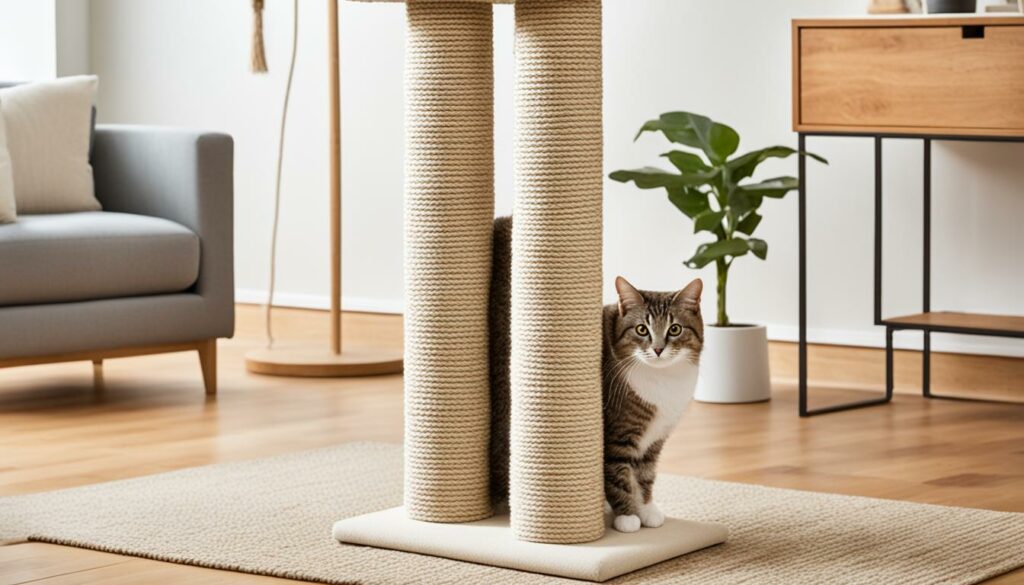
Before we dive into the solutions, let’s take a moment to understand why cats scratch furniture in the first place. Contrary to popular belief, their scratching behavior is not a sign of defiance or mischief. It’s actually a natural instinct deeply ingrained in their DNA.
So, how can we redirect this instinct and prevent cats from scratching our beloved furniture? From providing suitable scratching surfaces to trimming your cat’s nails regularly, we’ll explore a range of effective techniques to keep those claws away from your couch.
Key Takeaways:
- Understanding why cats scratch furniture is crucial in finding effective solutions.
- Providing appropriate scratching surfaces, such as scratching posts, can redirect their behavior.
- Regularly trimming your cat’s nails helps minimize the damage they can cause.
- Using deterrents and optimizing your home environment can discourage scratching.
- Training your cat to use appropriate scratching surfaces is possible with the right techniques.
Understanding Cat Scratching Behavior
Before we delve into the solutions, let’s take a closer look at why cats scratch and why it’s such a natural instinct for them. Understanding the reasons behind cat scratching behavior can help us address the issue more effectively.
Cats scratch for a variety of reasons:
- Marking territory: Scratching allows cats to leave a visual mark, thanks to the scratch marks they leave behind. It’s a way for them to establish their territory and communicate with other cats.
- Maintaining nail health: Scratching helps cats shed the outer layer of their nails, keeping them strong and healthy.
- Stretching and exercise: Cats scratch to stretch their muscles, particularly in their shoulders and legs. It’s a form of exercise and helps keep them physically fit.
Now that we understand why cats scratch, it’s easier to see why they gravitate towards furniture. The texture of furniture upholstery can be appealing to them, providing the perfect surface for scratching.
To protect your furniture and redirect your cat’s scratching behavior, it’s important to provide appropriate alternatives. In the next section, we’ll explore the different types of scratching posts and surfaces that can help fulfill your cat’s scratching needs while keeping your furniture safe.
Provide Appropriate Scratching Surfaces
In order to prevent your cat from scratching your furniture, it’s essential to provide them with appropriate scratching surfaces. Cats have a natural instinct to scratch, and offering them suitable alternatives can help redirect their behavior.
One of the most effective options is a cat-scratching post. These posts are specially designed for cats to scratch and provide a satisfying experience. When choosing a scratching post, consider its height and stability. Cats enjoy stretching while they scratch, so a tall post allows them to fully extend their bodies.
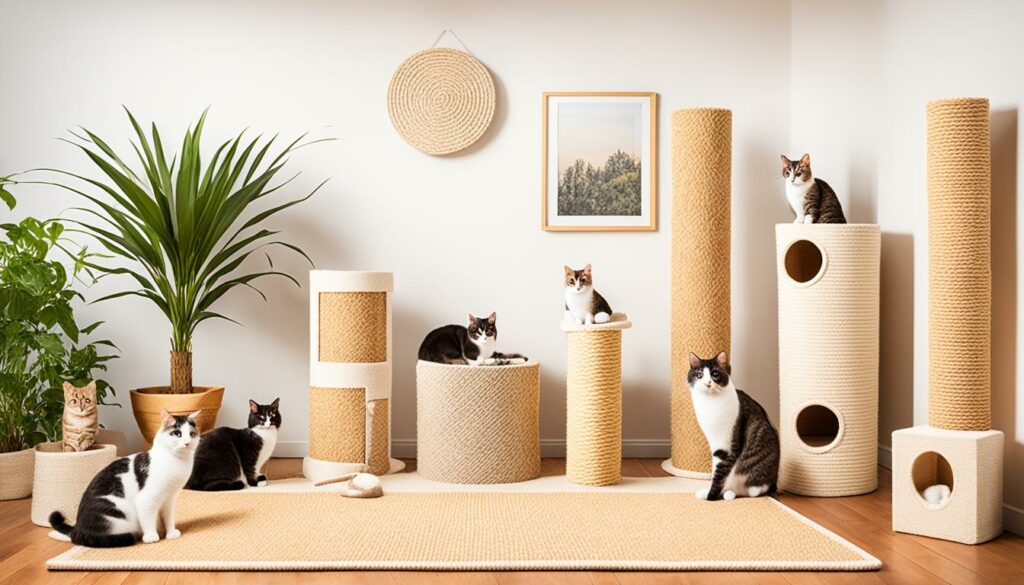
Types of Scratching Posts
There are various types of scratching posts available, and it’s important to find one that suits your cat’s preferences. Here are some popular options:
- Sisal Posts: These posts are covered in natural sisal rope, which cats find appealing to sink their claws into.
- Carpeted Posts: Some cats prefer the texture of carpeted surfaces, so a scratching post with carpeting might be enticing to them.
- Cardboard Scratchers: While not technically a post, cardboard scratchers provide an excellent temporary scratching surface. They are affordable and can be easily replaced once worn out.
Experiment with different types of scratching posts to see which one your cat prefers. It’s also a good idea to place multiple scratching posts throughout your home in different locations. This will ensure your cat always has access to a scratching surface when the urge strikes.
-
 $49.99Shop on Amazon
$49.99Shop on AmazonThe SmartCat Ultimate Scratching Post is a durable, large 32-inch tower made of sisal fiber. It's designed for cats of all breeds and sizes, providing a tall and strong structure to satisfy their natural scratching urges, thereby protecting furniture. Its simple design and easy setup make it a practical addition to any home.
We earn a commission if you click this link and make a purchase at no additional cost to you.
04/04/2025 07:55 am GMT -
 $22.79Shop on Amazon
$22.79Shop on AmazonThe Amazon Basics Cat Scratching Post is a medium-sized, grey scratching post designed for cats. It is 31.5 inches tall and features a sturdy base to prevent tipping. The post is covered in natural jute fiber, providing an optimal scratching surface for cats. It's ideal for keeping your cat's nails healthy and protecting furniture from scratches. Easy to assemble and highly rated for its sturdiness and value, it's a popular choice among cat owners.
We earn a commission if you click this link and make a purchase at no additional cost to you.
04/04/2025 07:50 am GMT -
 $34.59Shop on Amazon
$34.59Shop on AmazonThe 34" Tall Cat Scratching Post is designed for durability and stability. It features a heavy-duty sisal rope construction ideal for active cats. Interactive elements like a hanging ball and mice keep cats engaged. The post is easy to assemble and recognized for its sturdiness and stability, making it a practical choice for indoor cats and adult felines.
We earn a commission if you click this link and make a purchase at no additional cost to you.
04/04/2025 07:40 am GMT -
 $35.99Shop on Amazon
$35.99Shop on AmazonThis Cat Scratching Post is designed for indoor cats and features a sisal rope covering for durability. Standing 35 inches tall, it's suitable for cats of all sizes to stretch and scratch. The product is known for its stability, with a wider and thicker base to prevent tipping. It also includes a sisal hanging ball for added entertainment. Available in green, this scratching post blends with home decor and is made from safe, non-toxic materials.
We earn a commission if you click this link and make a purchase at no additional cost to you.
04/04/2025 07:35 am GMT -
 $25.99Shop on Amazon
$25.99Shop on AmazonThis 25-inch vertical scratcher is made with premium sisal and designed for indoor cats and kittens. It features tracking interactive toys to engage your cat further and is finished in a neutral beige tone to complement home decor. Its sturdy base ensures stability during use.
We earn a commission if you click this link and make a purchase at no additional cost to you.
04/04/2025 07:35 am GMT -
 $18.99Shop on Amazon
$18.99Shop on AmazonThe 29'' Cat Scratching Post is designed for cats of all sizes. It features a 29-inch height and natural sisal rope for durability. It includes 4 dangling toy balls to engage cats and is easy to assemble. Ideal for indoor use, it helps protect furniture by providing cats with an appealing scratching option.
We earn a commission if you click this link and make a purchase at no additional cost to you.
04/04/2025 07:35 am GMT -
 $28.97Shop on Amazon
$28.97Shop on AmazonThe 34" Tall Cat Scratching Post is a premium-quality sisal scratcher designed for indoor cats. It's made from natural sisal hemp and features a sturdy MDF base. The post is 34 inches tall, suitable for cats of all sizes, and includes a hanging ball for added play. It's easy to assemble and designed to protect furniture from scratches. The neutral color fits well with home decor.
We earn a commission if you click this link and make a purchase at no additional cost to you.
04/04/2025 06:40 am GMT -
 $19.99Shop on Amazon
$19.99Shop on AmazonThe SmartCat Ultimate Scratching Post is a sturdy and tall option for cats to satisfy their scratching needs. Made from durable sisal fiber, it allows for full stretches and muscle toning, preventing furniture damage. Easy to assemble, it blends well with home decor, making it both a functional and stylish choice for cat owners.
We earn a commission if you click this link and make a purchase at no additional cost to you.
04/04/2025 06:30 am GMT -
 $49.99Buy Now
$49.99Buy NowThe SmartCat Ultimate Scratching Post is a sturdy and tall option for cats to satisfy their scratching needs. Made from durable sisal fiber, it allows for full stretches and muscle toning, preventing furniture damage. Easy to assemble, it blends well with home decor, making it both a functional and stylish choice for cat owners.
We earn a commission if you click this link and make a purchase at no additional cost to you.
04/04/2025 06:15 am GMT -
 $35.79Buy Now
$35.79Buy NowThis cat activity tree provides an engaging space for your feline companions without taking up valuable floor area. Standing at 36.6 inches, it is designed for optimal stretching and scratching, suitable for cats of all ages and sizes. The use of sturdy pine and jute materials ensures durability and safety, creating an environmentally friendly product. Its easy installation allows you to mount it on any wall, integrating seamlessly into your living space. The DIY assembly design enables customization, so you can craft an ideal setup that suits your home and your pet's needs. This modern cat activity solution is both stylish and functional, promising a clutter-free addition to your home.
We earn a commission if you click this link and make a purchase at no additional cost to you.
04/04/2025 06:40 pm GMT
Trim Your Cat’s Nails Regularly
Cats have a natural instinct to scratch, which can result in damage to your furniture. One effective way to minimize this damage is to regularly trim your cat’s nails. Not only does nail trimming prevent scratches, but it also promotes your cat’s overall health and well-being.
To safely and effectively trim your cat’s nails, follow these step-by-step instructions:
- Gather the necessary tools: Before you begin, make sure you have a pair of cat nail clippers or human nail clippers with a straight edge. It’s also helpful to have some styptic powder or cornstarch on hand in case of any accidental bleeding.
- Choose the right time: Find a quiet and calm environment where your cat feels comfortable. It’s best to trim your cat’s nails when they are relaxed, such as after a meal or a play session.
- Gently hold your cat’s paw: Gently take your cat’s paw and press their pad to extend the nails.
- Identify the translucent portion: Locate the translucent portion of the nail called the “quick.” It’s essential to avoid cutting into the quick as it is sensitive and can cause bleeding.
- Start trimming: Carefully trim the tip of each nail, making sure to stay clear of the quick. If you are unsure, it’s better to trim less than to risk cutting too much.
- Reward your cat: After each successful trimming session, reward your cat with praise and a treat. This positive reinforcement will help create a positive association with nail trimming.
Regular nail trimming is an important part of cat care, as it not only prevents your furniture from being scratched but also reduces the chance of ingrown nails and other nail-related problems. If you are unsure about trimming your cat’s nails or if your cat is resistant, consult with a veterinarian or a professional groomer for assistance.
Did you know?
Trimming your cat’s nails every 2-4 weeks is usually sufficient to maintain their nail health and prevent damage to your furniture.
In addition to regular nail trimming, providing your cat with appropriate scratching surfaces and toys can further discourage them from scratching furniture. In the next section, we’ll explore different deterrents and training techniques to protect your furniture and ensure harmony in your home.
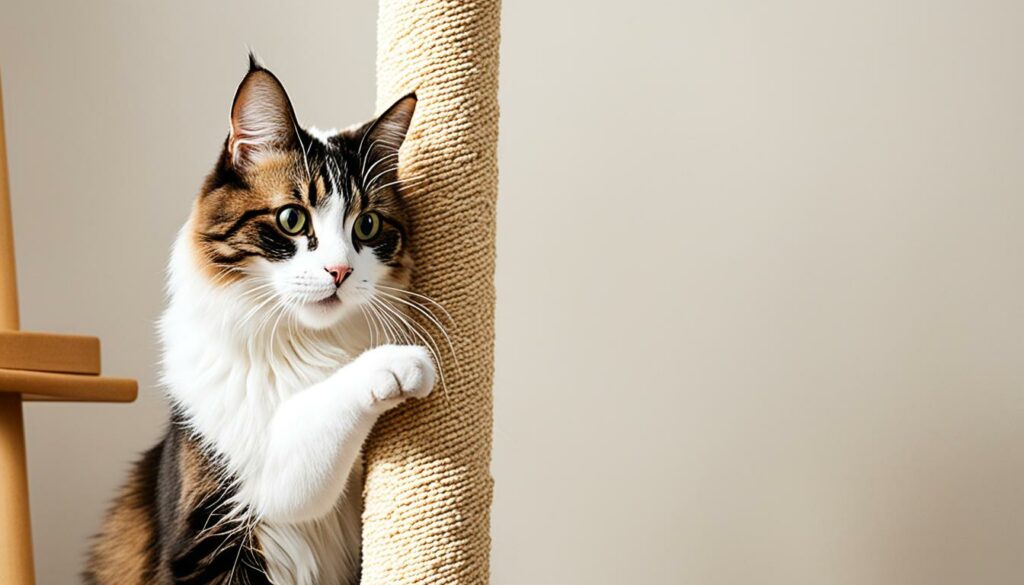
| Benefits of Regular Nail Trimming: |
|---|
| Prevents furniture damage |
| Reduces the chance of ingrown nails |
| Improves overall nail health |
| Provides positive reinforcement and bonding |
Employ Deterrents to Protect Furniture
Preventing cats from scratching furniture can be a challenge, but there are various deterrents you can use to discourage this behavior. By implementing these strategies, you can protect your furniture while keeping your feline friends happy and entertained.
1. Double-Sided Tape
Double-sided tape is an effective way to deter cats from scratching furniture. Place strips of tape on the areas your cat tends to scratch, such as the corners of sofas or the edges of tables. The sticky sensation on their paws will discourage them from scratching the furniture.

2. Provide Alternative Cat Toys
One of the reasons cats scratch furniture is to satisfy their instinctual need to “mark” their territory. By providing alternative toys and scratching surfaces, you can redirect their scratching behavior. Consider interactive toys, scratching posts, and tunnels to keep them engaged and entertained.
3. Address Multiple Cats’ Behavior
If you have many cats in your household, their scratching behavior can influence each other. It’s essential to observe their interactions and address any territorial disputes or competition for resources. Providing multiple scratching posts and toys can help reduce conflicts and redirect their scratching instincts.
“By employing deterrents and providing alternative scratching surfaces, you can protect your furniture while promoting healthy cat behavior.” – Cat Behavior Expert
Summary:
Discouraging cats from scratching furniture involves employing practical strategies such as double-sided tape, providing alternative toys, and addressing multiple cats’ behavior. By redirecting their scratching instincts and offering appropriate alternatives, you can protect your furniture and maintain a harmonious environment for both you and your feline companions.
Optimize your Home Environment
Creating an environment that caters to your cat’s scratching needs is crucial. By providing appropriate scratching surfaces, you can redirect their natural behavior and protect your furniture. Horizontal scratching posts and cat trees are excellent choices to meet your cat’s scratching instincts.

Horizontal scratching posts are designed to mimic the feeling of scratching on the ground, which many cats tend to prefer. They offer a comfortable and familiar surface for your cat to scratch, reducing the chances of them turning to your furniture. Placing a horizontal scratching post near your cat’s favorite resting spot or near the furniture they frequently scratch can effectively redirect their scratching behavior.
Cat trees are another valuable addition to your home. They provide multiple benefits as they not only serve as scratching surfaces but also offer platforms for climbing, playing, and lounging. Cats tend to be attracted to elevated areas, and providing them with a dedicated cat tree can help satisfy their natural instincts while keeping your furniture safe.
| Benefits of Horizontal Scratching Posts and Cat Trees |
|---|
| 1. Redirects cat’s scratching behavior away from furniture |
| 2. Provides a comfortable and familiar scratching surface |
| 3. Offers additional features like climbing and playing platforms |
| 4. Satisfies a cat’s natural instinct for elevated areas |
Ensure that the horizontal scratching posts and cat trees are sturdy and stable to withstand your cat’s scratching and climbing activities. Introduce them gradually to your cat and encourage their use by placing enticing toys or treats near the surfaces. Positive reinforcement, such as praising and rewarding your cat when they use the scratching posts or cat trees, can also reinforce the desired behavior.
Cat Training Techniques
Training your cat to stop scratching furniture is a manageable task with the right techniques. By redirecting their scratching behavior to appropriate surfaces, you can protect your furniture and maintain a harmonious living environment.
Positive Reinforcement
One effective cat training technique to prevent furniture scratching is using positive reinforcement. Cats respond well to rewards and praise when they exhibit desirable behavior.
“Reward your cat with treats or verbal praise each time they use the scratching post instead of your furniture.”
This positive association will help your cat understand that scratching the designated surface is more beneficial and enjoyable than scratching the furniture.
Teaching to Use Appropriate Scratching Surfaces
Most cats instinctively understand the purpose of scratching, but they need guidance on where to direct their claws. Here are practical steps you can take to teach your cat to use appropriate scratching surfaces:
- Place the scratching post near the furniture your cat likes to scratch.
- Encourage your cat to investigate the scratching post by using a toy or a sprinkle of catnip on it.
- Gently guide your cat’s paws to the scratching post and mimic scratching motions.
- Repeat this process several times, providing positive reinforcement when your cat uses the scratching post.
Consistency and repetition are key to ingraining this behavior in your furry friend.
Understanding Cat’s Claws
To effectively train your cat, it’s important to understand the nature of cat’s claws. Cats scratch for various reasons, including stretching, marking territory, and maintaining claw health.
Scratching not only helps cats remove the outer sheath of their claws but also allows them to exercise their paws, promoting muscle strength and flexibility. Understanding the importance of scratching will help you appreciate the need for appropriate outlets for this natural behavior.
To give you a better insight into the structure of a cat’s claws, refer to the diagram below:
| Cat’s Paw Anatomy | |
|---|---|
| Claw: The sharp and curved structure used for scratching and catching prey. Pad: The cushion-like part of the paw that provides support and balance. Dew Claw: The fifth claw located on the inner side of the paw, slightly higher than the rest. Digital Pads: The soft, textured pads on the underside of the paw that help with grip and facilitate movement. |
Understanding the intricacies of a cat’s claws will help you prioritize their physical and behavioral needs, leading to better training outcomes.
Alternative Solutions for Specific Cases
In some cases, traditional scratching post solutions may not be suitable for every situation. If you have leather furniture or you’re an animal lover seeking alternative options, there are several effective alternatives to consider. These solutions can help you protect your furniture while still providing your furry friend with an outlet for their natural scratching instincts.
Soft Paws
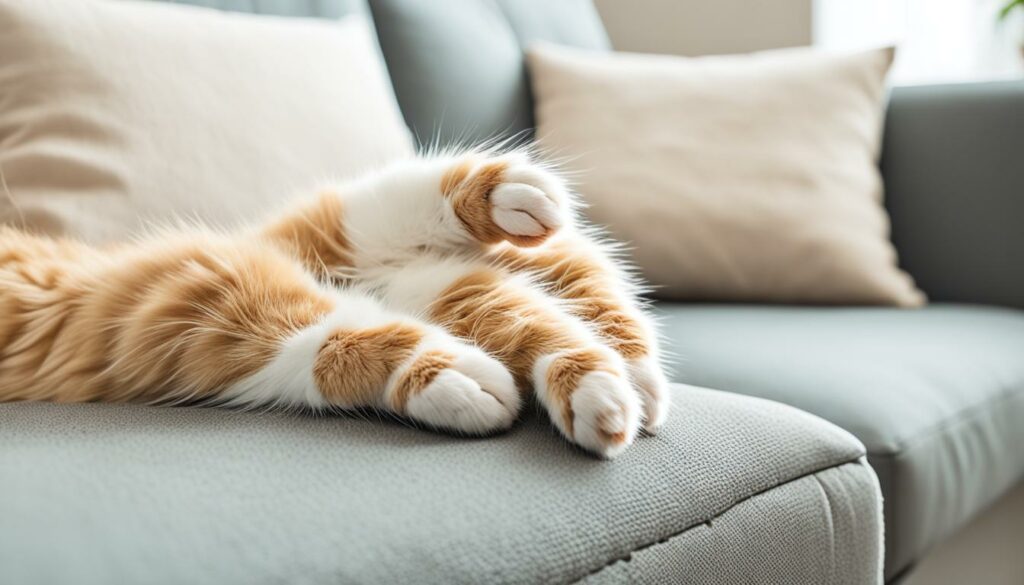
Soft paws are a safe and humane option for protecting both your furniture and your cat’s paws. These are small rubber caps that can be attached to your cat’s claws using adhesive. Soft paws prevent your cat from scratching and causing damage, while still allowing them to retract their claws naturally. They are available in various sizes and colors to suit your cat’s needs.
Sisal Rope Wraps
If your cat is particularly fond of scratching furniture with sisal rope or you have furniture with sisal rope accents, consider using sisal rope wraps. These wraps can be securely attached to the areas your cat likes to scratch, providing a designated scratching surface that mimics the texture of sisal rope. This can help divert your cat’s scratching behavior away from your furniture.
Pheromone Sprays
Pheromone sprays are designed to create a calming environment for your cat and discourage undesirable scratching behavior. By spraying pheromone-based products on your furniture, you can help deter your cat from scratching those areas. These sprays mimic natural pheromones that cats release when they feel happy and relaxed, signaling to them that the furniture is not an appropriate scratching surface.
Remember, some solutions may work better for certain cats or specific furniture materials, so it’s important to find what works best for your individual situation. Experimenting with different alternatives can help you find the perfect solution to protect your furniture and keep your furry friend content.
Conclusion
In conclusion, understanding your cat’s scratching behavior is vital in maintaining a harmonious living environment. By providing appropriate alternatives, you can redirect their scratching instincts away from your furniture. Throughout this article, we have discussed various strategies to achieve that.
First and foremost, the importance of providing suitable scratching surfaces cannot be overstated. Investing in high-quality scratching posts and encouraging your cat to use them will greatly reduce furniture damage. Trimming your cat’s nails regularly is also essential, as it minimizes the potential harm they can cause.
Additionally, employing deterrents such as double-sided tape and offering alternative toys can discourage your cat from scratching furniture. Optimizing your home environment by strategically placing horizontal scratching posts and cat trees is another effective measure. Finally, training your cat using positive reinforcement techniques will help them develop a preference for appropriate scratching surfaces.
By implementing these strategies in combination, you can create a cat-friendly space where your furry friend can fulfill their scratching needs while keeping your furniture intact. Remember, patience and consistency are key to successful behavior modification. With time and understanding, you and your cat can enjoy a happy and scratch-free coexistence.
FAQ
How can I keep my cats from scratching furniture?
There are several effective strategies you can try. Providing scratching posts, regularly trimming your cat’s nails, using deterrents like double-sided tape, and optimizing your home environment can all help prevent cats from scratching your furniture.
Why do cats scratch furniture?
Scratching is a natural behavior for cats. They scratch to stretch their muscles, mark their territory, and remove the dead outer layers of their claws.
What types of scratching surfaces should I provide for my cat?
Cats have different preferences when it comes to scratching surfaces. It’s important to provide various options such as scratching posts covered in sisal rope or corrugated cardboard. Some cats also enjoy horizontal scratching pads or cat trees with multiple levels.
How do I trim my cat’s nails?
Trimming your cat’s nails regularly is essential. Use cat-specific nail clippers and be careful not to cut into the quick, which is the sensitive part of the nail. If you’re unsure, consult your veterinarian or a professional groomer for guidance.
What can I do to deter my cat from scratching furniture?
There are several deterrents you can try. Applying double-sided tape to the furniture, offering alternative toys or scratching posts, and addressing any behavioral issues caused by multiple cats in the household can help discourage scratching.
Can I train my cat to stop scratching furniture?
Yes, training techniques can be effective in redirecting your cat’s scratching behavior. Positive reinforcement, such as providing treats and praise when your cat uses appropriate scratching surfaces, can help train them to avoid furniture.
What are some alternative solutions for specific cases?
If you have leather furniture or prefer not to use deterrents, you can consider options like using soft paws (feline nail caps), using sisal rope to cover furniture edges, or using pheromone sprays that can help calm and relieve stress in cats.
This website contains affiliate links. Some products are gifted by the brand to test. As an Amazon Associate, I earn from qualifying purchases. The content on this website was created with the help of AI.
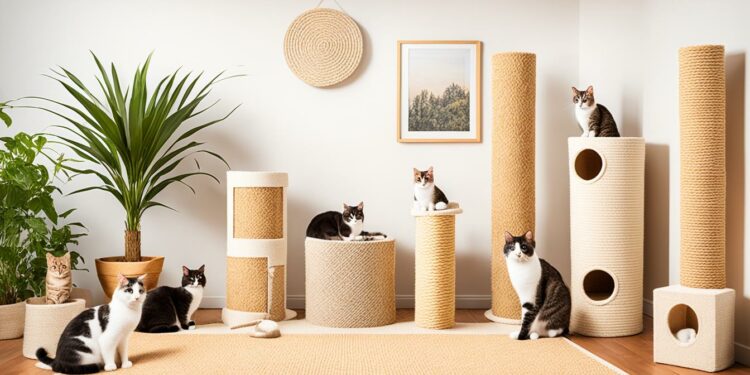









 when your cat bites
when your cat bites